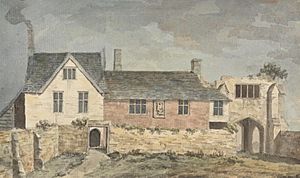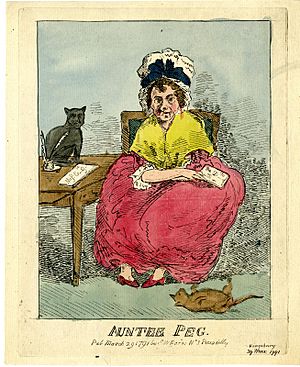Margaret Minifie facts for kids
Quick facts for kids
Margaret Minifie
|
|
|---|---|
| Born | 15 July 1734 Staplegrove, Somerset |
| Died | 11 May 1803 (aged 68) |
| Resting place | Staplegrove, Somerset |
| Occupation | Writer |
| Nationality | British |
| Relatives | Susannah Gunning, sister; Elizabeth Gunning, niece |
Margaret Minifie (born July 15, 1734 – died May 11, 1803) was a British writer from the 1700s. She wrote novels that explored feelings and emotions. For a long time, her writing career was not as well-known as her sister's, Susannah Gunning. Some of Margaret's books were even thought to be written by Susannah. However, experts are now working to understand Margaret's own unique story and contributions.
Contents
About Margaret Minifie's Life
Margaret Minifie was born in Staplegrove, a village near Taunton in Somerset, England. Her father, James Minifie (1707–1789), was a clergyman. Her mother was also named Margaret Minifie (1710–1782).
Margaret never married. She was very close to her sister, Susannah. Because of this, she lived with Susannah and her family for most of her life. Margaret passed away at the age of 68. She was buried in Staplegrove, the same place where she was born.
Margaret Minifie's Books
Margaret's sister, Susannah, was also a writer. The two sisters worked together on at least two novels. Their first joint book was The histories of Lady Frances S— and Lady Caroline S— (1763). This was a popular novel about emotions and letters, and it was printed a second time. They also wrote The Picture together in 1766.
Susannah went on to write four more novels on her own. However, she seemed to stop writing for a while after she married John Gunning. During this time, two novels were published that were often thought to be Susannah's: The Count de Poland (1780) and Coombe Wood (1783). Experts now believe that Margaret Minifie almost certainly wrote these two books.
Margaret herself took a break from writing for 20 years. Her last novel, The Union, was published in 1801. Margaret Minifie is recognized by some experts as one of "100 good women writers before Jane Austen."
Caricatures and Public Image
We don't have any official paintings or portraits of Margaret Minifie. However, there are several funny or exaggerated drawings called caricatures. These were made by famous artists like James Gilray and Isaac Cruikshank. These drawings came about because of a public disagreement in 1791. This event involved Margaret's niece, the novelist Elizabeth Gunning (1769–1823).
Margaret's exact part in this public event is not fully known. The caricatures showed Margaret in a way that was not very kind. They often showed her as an older woman who was unmarried. One drawing by Cruikshank also made fun of her job as a writer. It showed her sitting at a table surrounded by writing tools and cats. This was a way to criticize the sisters' books, as some harsh critics thought their writing was not very good.
Margaret Minifie had a long career as a popular novelist. Even though she might not be considered one of the most important writers in history, her work is now gaining interest. Researchers are studying her and other women writers who were overlooked. They are also looking at popular stories, emotional novels, and how books were read and published in the 1700s.
Online Books
- Barford Abbey, Internet Archive
- Coombe Wood, Vol. I & Vol. II, Internet Archive
See also
- List of early-modern British women novelists



